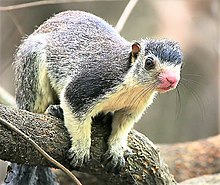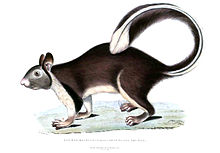
The bar-winged flycatcher-shrike is a small passerine bird usually placed in the Vangidae. It is found in the forests of tropical southern Asia from the Himalayas and hills of southern India to Indonesia. Mainly insectivorous it is found hunting in the mid-canopy of forests, often joining mixed-species foraging flocks. They perch upright and have a distinctive pattern of black and white, males being more shiny black than the females. In some populations the colour of the back is brownish while others have a dark wash on the underside.

The spot-bellied eagle-owl, also known as the forest eagle-owl is a large bird of prey with a formidable appearance. It is a forest-inhabiting species found in the Indian Subcontinent and Southeast Asia. This species is considered part of a superspecies with the barred eagle-owl, which looks quite similar but is allopatric in distribution.

The Malabar Coast moist forests are a tropical moist broadleaf forest ecoregion of southwestern India.

The South Western Ghats moist deciduous forests is an ecoregion in the Western Ghats of southern India with tropical and subtropical moist broadleaf forests. This biome covers the Nilgiri Hills between elevation of 250 and 1,000 m in Kerala, Karnataka and Tamil Nadu states.
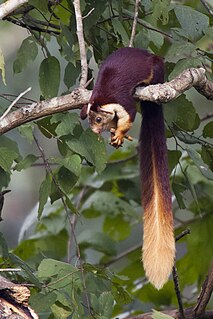
The Indian giant squirrel or Malabar giant squirrel is a large multi-coloured tree squirrel species endemic to forests and woodlands in India. It is a diurnal, arboreal, and mainly herbivorous squirrel.
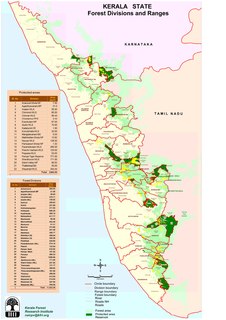
Most of Kerala, whose native habitat consists of wet evergreen rainforests at lower elevations and highland deciduous and semi-evergreen forests in the east, is subject to a humid tropical climate. However, significant variations in terrain and elevation have resulted in a land whose biodiversity registers as among the world’s most significant. But the district Alappuzha situated in Kerala is the only district of Kerala which have no forests.

The stripe-necked mongoose is a mongoose species native to forests and shrublands from southern India to Sri Lanka.
Meghamalai, commonly known as the High Wavy Mountains, is a mountain range located in the Western Ghats in the Theni district near Kumily, Tamil Nadu. It is dotted with cardamom plantations and tea plantations. The mountain range is 1,500 metres above sea level, and it is rich in flora and fauna. The area, now mostly planted with tea plants, includes cloudlands, high wavys, venniar, and the manalar estates belonging to the Woodbriar Group. Access is largely restricted and includes largely untouched remnants of evergreen forest.

The Grizzled Squirrel Wildlife Sanctuary (GSWS), also known as Srivilliputhur Wildlife Sanctuary, was established in 1988 to protect the Near threatened grizzled giant squirrel. Occupying an area of 485.2 km2, it is bordered on the southwest by the Periyar Tiger Reserve and is one of the best preserved forests south of the Palghat Gap.
Travancore flying squirrel, also known as the small flying squirrel, is a flying squirrel found in South India and Sri Lanka. Travancore flying squirrels were thought to be extinct but were rediscovered in 1989 after a gap of 100 years in Kerala. It was rediscovered in Sri Lanka after 78 years. The animals were reported only in wet and intermediate zones of the island, and had a few sightings in the Sinharaja Forest Reserve.
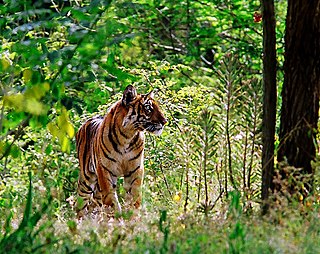
There are more than 2000 species of fauna that can be found in Tamil Nadu. This rich wildlife is attributed to the diverse relief features as well as favorable climate and vegetation in the Indian state. Recognizing the state's role in preserving the current environment, the state government has established several wildlife and bird sanctuaries as well as national parks, which entail stringent protective measures. Tamil Nadu is also included in the International Network of Biosphere Reserves, which facilitates international recognition and additional funding. There are five national parks and 17 sanctuaries that serve as homes to the wildlife.

The Indian giant flying squirrel, also called the large brown flying squirrel or the common giant flying squirrel, is a species of rodent in the family Sciuridae. It is capable of gliding flight using a skin membrane stretched between front and hind legs. It is found in mainland Southeast and South Asia, and southern and central China.

The cream-coloured giant squirrel or pale giant squirrel is a large tree squirrel in the genus Ratufa found in forests in the Thai-Malay Peninsula, Sumatra (Indonesia), Borneo and nearby small islands. The species is near threatened and vulnerable to habitat degradation, and it has probably been extirpated in Singapore where the last sighting was in 1995. Reported sightings in Vietnam in 1984 are considered to be dubious.

The black giant squirrel or Malayan giant squirrel is a large tree squirrel in the genus Ratufa native to the Indomalayan zootope. It is found in forests from northern Bangladesh, northeast India, eastern Nepal, Bhutan, southern China, Myanmar, Laos, Thailand, Malaysia, Cambodia, Vietnam, and western Indonesia.
Dhalavaipuram or Dhalavaipuram is a town in Rajapalayam Virudhunagar district in the Indian state of Tamil Nadu. It is located 105 km southwest of Madurai in the state of Tamil Nadu. The economy is based on the manufacture of Garments, cotton sarees, lungis, Nighties, Inskirt, Brassiere and there are mills for spinning and weaving cotton.
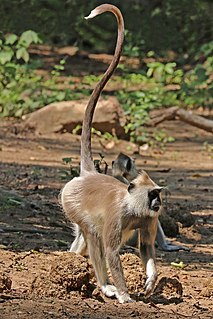
The tufted gray langur, also known as Madras gray langur, and Coromandel sacred langur, is an Old World monkey, one of the species of langurs. This, like other gray langurs, is mainly a leaf-eating monkey. It is found in southeast India and Sri Lanka. It is one of three Semnopithecus species named after characters from The Iliad, S. hector and S. ajax being the others. In Sinhala it is known as හැලි වදුරා.

The Melagiris are a range of hills on the Eastern Ghats, bound by the river Cauvery on the west. Melagiri contain an expanse of 1295 km2 of dry deciduous and semi-evergreen forests. It is an elephant country and contains two traditional elephant corridors. With the Bannerghatta National Park in the North east and Cauvery Wildlife Sanctuary in the south, the forest range stretches to sanctuaries of BR Hills and Sathyamangala and joins the tiger reserves of Nilgiri Biosphere. As the meeting point of the Western Ghats and Eastern Ghats, these forests form a vital link in the elephant corridors of South India, connecting the Bannerghatta National Park and the River Cauvery. It borders some of the prominent tiger sanctuaries of the south.
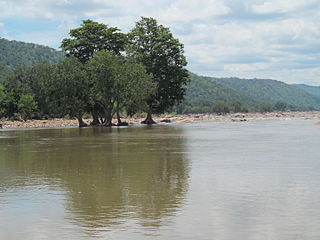
The Cauvery Wildlife Sanctuary is a protected area located in the Mandya, Chamarajanagar and Ramanagar districts of Karnataka, India. The Cauvery River passes through its midst. An area of 510.52 km2 (197.11 sq mi) was established as Cauvery Wildlife Sanctuary on 14 January 1987 under Section 18 of the Wildlife Protection Act 1972 with the objective of providing protection, conservation and development of Wildlife and its environment. The sanctuary was expanded to its current area of 102,753 hectares in 2013. On its east, it adjoins Dharmapuri forest division of Tamil Nadu state.
Pakkamalai is a mountain and forest reserve in Villupuram district of Tamil Nadu, located 45 km southwest of Gingee.
Squirrel poaching includes any poaching of any squirrel.
